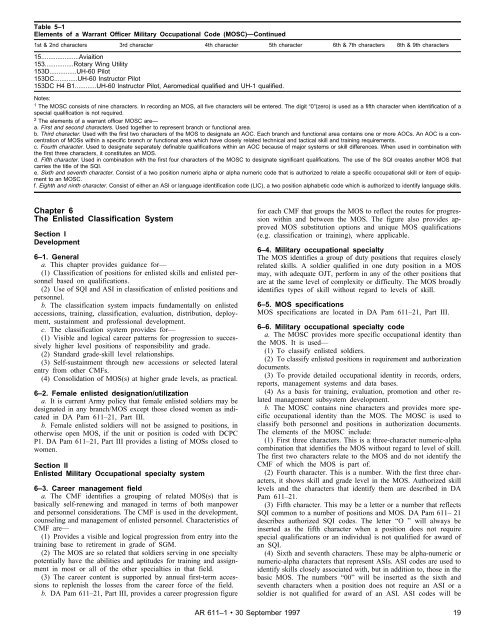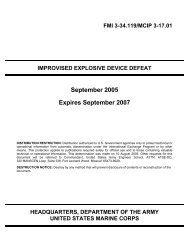AR 611-1 - Soldier Support Institute - U.S. Army
AR 611-1 - Soldier Support Institute - U.S. Army
AR 611-1 - Soldier Support Institute - U.S. Army
- No tags were found...
Create successful ePaper yourself
Turn your PDF publications into a flip-book with our unique Google optimized e-Paper software.
Table 5–1Elements of a Warrant Officer Military Occupational Code (MOSC)—Continued1st & 2nd characters 3rd character 4th character 5th character 6th & 7th characters 8th & 9th characters15.....................Aviaition153................Rotary Wing Utility153D...............UH-60 Pilot153DC.............UH-60 Instructor Pilot153DC H4 B1............UH-60 Instructor Pilot, Aeromedical qualified and UH-1 qualified.Notes:1 The MOSC consists of nine characters. In recording an MOS, all five characters will be entered. The digit “0”(zero) is used as a fifth character when identification of aspecial qualification is not required.2 The elements of a warrant officer MOSC are—a. First and second characters. Used together to represent branch or functional area.b. Third character. Used with the first two characters of the MOS to designate an AOC. Each branch and functional area contains one or more AOCs. An AOC is a concentrationof MOSs within a specific branch or functional area which have closely related technical and tactical skill and training requirements.c. Fourth character. Used to designate separately definable qualifications within an AOC because of major systems or skill differences. When used in combination withthe first three characters, it constitutes an MOS.d. Fifth character. Used in combination with the first four characters of the MOSC to designate significant qualifications. The use of the SQI creates another MOS thatcarries the title of the SQI.e. Sixth and seventh character. Consist of a two position numeric alpha or alpha numeric code that is authorized to relate a specific occupational skill or item of equipmentto an MOSC.f. Eighth and ninth character. Consist of either an ASI or language identification code (LIC), a two position alphabetic code which is authorized to identify language skills.Chapter 6The Enlisted Classification SystemSection IDevelopment6–1. Generala. This chapter provides guidance for—(1) Classification of positions for enlisted skills and enlisted personnelbased on qualifications.(2) Use of SQI and ASI in classification of enlisted positions andpersonnel.b. The classification system impacts fundamentally on enlistedaccessions, training, classification, evaluation, distribution, deployment,sustainment and professional development.c. The classification system provides for—(1) Visible and logical career patterns for progression to successivelyhigher level positions of responsibility and grade.(2) Standard grade-skill level relationships.(3) Self-sustainment through new accessions or selected lateralentry from other CMFs.(4) Consolidation of MOS(s) at higher grade levels, as practical.6–2. Female enlisted designation/utilizationa. It is current <strong>Army</strong> policy that female enlisted soldiers may bedesignated in any branch/MOS except those closed women as indicatedin DA Pam <strong>611</strong>–21, Part III.b. Female enlisted soldiers will not be assigned to positions, inotherwise open MOS, if the unit or position is coded with DCPCP1. DA Pam <strong>611</strong>–21, Part III provides a listing of MOSs closed towomen.Section IIEnlisted Military Occupational specialty system6–3. Career management fielda. The CMF identifies a grouping of related MOS(s) that isbasically self-renewing and managed in terms of both manpowerand personnel considerations. The CMF is used in the development,counseling and management of enlisted personnel. Characteristics ofCMF are—(1) Provides a visible and logical progression from entry into thetraining base to retirement in grade of SGM.(2) The MOS are so related that soldiers serving in one specialtypotentially have the abilities and aptitudes for training and assignmentin most or all of the other specialties in that field.(3) The career content is supported by annual first-term accessionsto replenish the losses from the career force of the field.b. DA Pam <strong>611</strong>–21, Part III, provides a career progression figurefor each CMF that groups the MOS to reflect the routes for progressionwithin and between the MOS. The figure also provides approvedMOS substitution options and unique MOS qualifications(e.g. classification or training), where applicable.6–4. Military occupational specialtyThe MOS identifies a group of duty positions that requires closelyrelated skills. A soldier qualified in one duty position in a MOSmay, with adequate OJT, perform in any of the other positions thatare at the same level of complexity or difficulty. The MOS broadlyidentifies types of skill without regard to levels of skill.6–5. MOS specificationsMOS specifications are located in DA Pam <strong>611</strong>–21, Part III.6–6. Military occupational specialty codea. The MOSC provides more specific occupational identity thanthe MOS. It is used—(1) To classify enlisted soldiers.(2) To classify enlisted positions in requirement and authorizationdocuments.(3) To provide detailed occupational identity in records, orders,reports, management systems and data bases.(4) As a basis for training, evaluation, promotion and other relatedmanagement subsystem development.b. The MOSC contains nine characters and provides more specificoccupational identity than the MOS. The MOSC is used toclassify both personnel and positions in authorization documents.The elements of the MOSC include:(1) First three characters. This is a three-character numeric-alphacombination that identifies the MOS without regard to level of skill.The first two characters relate to the MOS and do not identify theCMF of which the MOS is part of.(2) Fourth character. This is a number. With the first three characters,it shows skill and grade level in the MOS. Authorized skilllevels and the characters that identify them are described in DAPam <strong>611</strong>–21.(3) Fifth character. This may be a letter or a number that reflectsSQI common to a number of positions and MOS. DA Pam <strong>611</strong>– 21describes authorized SQI codes. The letter “O ” will always beinserted as the fifth character when a position does not requirespecial qualifications or an individual is not qualified for award ofan SQI.(4) Sixth and seventh characters. These may be alpha-numeric ornumeric-alpha characters that represent ASIs. ASI codes are used toidentify skills closely associated with, but in addition to, those in thebasic MOS. The numbers “00” will be inserted as the sixth andseventh characters when a position does not require an ASI or asoldier is not qualified for award of an ASI. ASI codes will be<strong>AR</strong> <strong>611</strong>–1 • 30 September 199719
















